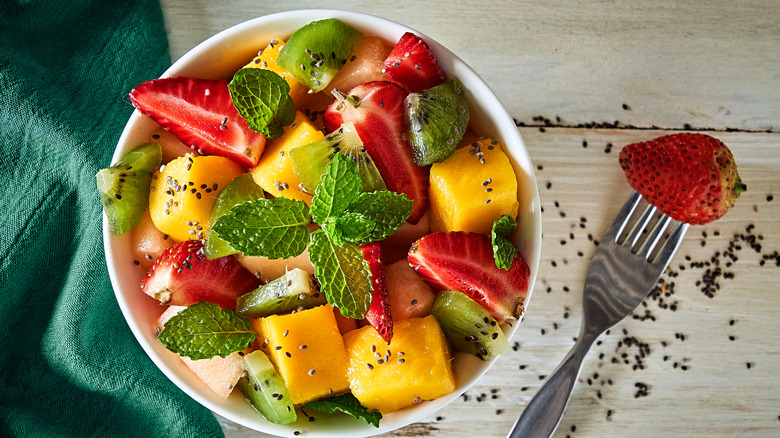This Candied Addition Is What Your Fruit Salad Has Been Missing
Waste not, want not is a common refrain among food lovers who understand that "nose to tail" and "seed to stem" style philosophies don't just make environmental sense, but open up a world of delicious culinary possibilities. A great place to start is by looking more closely at ingredients already in heavy rotation, and while a squeeze of orange juice can boost just about any dish or provide the foundation for a cocktail or punch, the fruit's peel — normally destined for the compost bin — is packed with flavor and aromatic essential oils, too.
The reason most people don't pop the peel into their mouths as a simple snack, though, is their profound bitterness. Untreated, eating an orange peel is a puckering, astringent, and — for most people — off-putting experience. But by taking the time to candy your orange's skin (aided by an orange peeling trick that perfectly preserves the peel), you can transform those bits and slices into total culinary treasures. And while their uses are myriad, they can level up a basic fruit salad to another stratosphere of satisfaction.
How candied orange peels are made perfect
Candied orange peels bring so much to your fruit salad. The bittersweet pop of flavor is a surprising and delightful contrast to the natural sweetness of your chosen fruits, while the chewy, crystalized texture offers contrast. They even add an aesthetic appeal, looking like little glittery gems throughout. Preparing them takes a bit of time, but the straightforward process is totally worth the effort.
Orange peels contain compounds known as naringin and limonin, and while there are scientists out there trying to develop methods for tamping down those bitter flavors (thus creating a fruit with a longer shelf life), for now there is a tried and true process for lessening that bitter bite, and that's blanching — the first step to creating candied orange peels. By boiling and draining about three or four times, you can remove some of those hot water-soluble compounds, leaving you with peels that are more mellow and prepared to be sweetened up.
Naturally, another strategy for taming bitterness is to combat it with sugar, which brings us to the next important element for your orange peel creations: candying. Once the blanching process is complete, proceeding to boil the peels in simple syrup and then tossing them in more sugar creates that signature bitter-sweet balance that is beloved by so many (as evidenced by the Negroni cocktail's popularity). It also gives your candied orange that signature texture that's so fun as contrast in a fruit salad.
Using your candied orange for fruit salad and more
Candied orange are practically perfect with this simple process, but you can also add a little flair by using a flavored sugar, vanilla extract (for a creamsicle spin), or adding a pinch of salt. It's up to you whether you prefer to keep them in long strips (ideal for snacking), or mince them into bits that you can toss into your dish. This also works for other citrus, if you'd prefer to branch out, or make candied citrus confetti.
Once candied orange peels are prepared, you can start strategizing for your fruit salad. Tropical flavors like pineapple, papaya, mango, cantaloupe, and coconut welcome your citrus pops, as will salads that stick to summer berries and stone fruit, or even autumnal offerings like pears, cranberries, and apples. There are so many ways to easily elevate your fruit salad. Herbs like mint, basil, sage, and rosemary all pair well with this sugary orange flavor, and if you grill your fruit, those caramelized bits are a natural complement to sweetened citrus. Spices are also a great boost; orange and coriander have a long history together, but a kick from cayenne wouldn't hurt either. Crunchy nuts or creamy cheeses add extra texture along with the candied orange. There are so many ways to put your candied citrus to use, but for fruit-lovers, this tasty salad trick means never wasting an opportunity to enjoy our natural treasures in all their glory.


